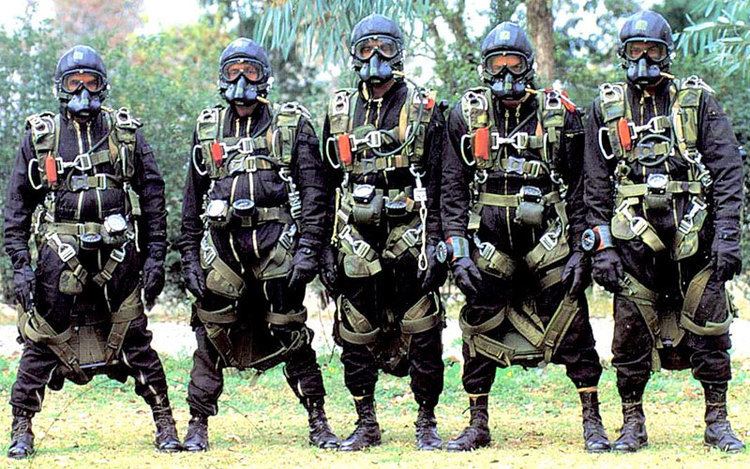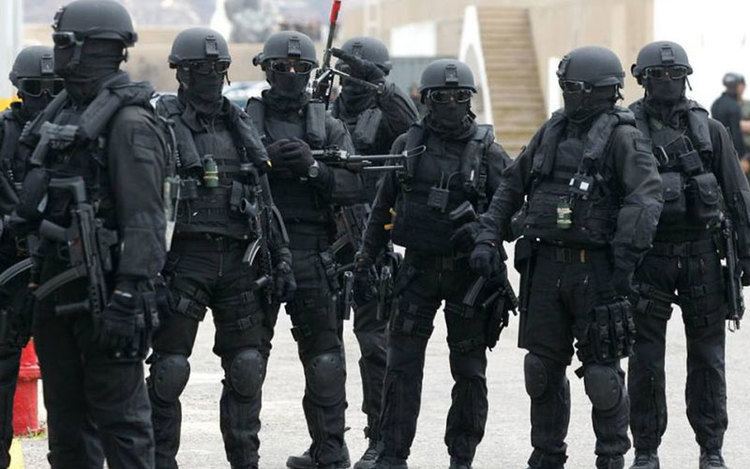Country Pakistan Branch Pakistan Army | Allegiance Pakistan Army Role Special Operations | |
 | ||
Active 23 March 1956 – present Type Special Operations Forces | ||
The Special Service Group (SSG) (Urdu: خصوصی خدمات انجمن) is the primary special operations force of the Pakistan Army. The SSG is a regiment-sized unit, and is headquartered at Tarbela Cantonment. It is headed by a major-general and divided into eight battalions. Each battalion consists of 700 men in four companies, with each company split into platoons and then into 10-man teams. Each battalion is commanded by a lieutenant colonel.
Contents
- Ssg special services group pakistan
- 19th Baluch SSG Pak
- Indo Pakistan War of 1965
- Indo Pakistan War of 1971
- SSG involvement in Soviet Afghan War
- Siachen and Kargil War
- Musa Company
- Recent activities
- Military operations
- Counter terrorism operations
- Organization
- Training
- Interaction with other elite units
- Deployment
- Notable members
- Appearance and equipment
- Uniforms
- Equipment
- Recommended reading
- References

Ssg special services group pakistan
19th Baluch (SSG Pak)

SSG Pak was raised by amalgamating 7th/10th Baluch (19 Baluch) and 312 Garrison Company. Based out of Cherat and Attock, the SSG was created in 1956. That year, 19 Baluch was selected for conversion to a special operation force. As a result of this, the SSG has inherited many of the traditions and insignia of the Baloch Regiment. The 19th Baluch Regiment's first commanding officer was Lieutenant Colonel (later Major General) Aboobaker Osman Mitha who commanded it for six years till 1961. The first commander of its Alpha Company was Major (later Lieutenant Colonel) Gaideen Khan Abdullai Mahsud. Their initial training and orientation as regards tactics was based on the US Special Forces pattern with whom they co-operated closely in the Cold War years. The SSG initially had 6 companies and each company had specialization units, specialized in desert, mountain, ranger, and underwater warfare. The desert companies participated in training exercises with US Army Special Forces Mobile Training Team in late 1964. In August 1965, scope of SSG was raised from a battalion size force to larger Special Operations outfit and instead of 19 Baluch (SSG) they simply adopted the name Special Services Group. The scuba company in Karachi was renowned for its tough physical training. Later on, Chinese training, tactics, weapons, and equipment were also introduced.
Indo-Pakistan War of 1965

The SSG guerrillas were initially deployed along the Afghan border to repel Afghan incursions into Pakistan, but their first major deployment came during the war of 1965. By 1971, the SSG had grown to 3 battalions with 1 permanently stationed in East Pakistan.
Indo-Pakistan War of 1971

In 1971, SSG comprised three battalions of which one (3rd Commando Battalion) was stationed in East Pakistan. In one of the raids on an Indian artillery regiment during the 1971 Indo-Pak war, 1 Commando Battalion incapacitated number of their guns.
SSG involvement in Soviet Afghan War
During Operation Magistral, it is alleged that the SSG came into regular contact with Soviet forces. One of these incidents was the Battle for Hill 3234, where a company of Soviet paratroopers engaged a force of Mujahideen believed to be SSG. The Mujahideen wore black uniforms with rectangular black-yellow-red stripes. It is claimed by at least two sources that the Mujahideen were actually members of the Special Services Group. According to the Soviet estimates, the SSG lost over 200 men.
Another battle reported as having been fought between the Pakistanis and Soviet troops occurred in Kunar Province in March 1986. But the Russians claim that the battle was actually fought between the GRU 15th Spetsnaz Brigade and the Asama Bin Zaid regiment of the Afghan Mujahideen under Commander Assadullah, belonging to Abdul Rasul Sayyaf's faction.
Siachen and Kargil War
The SSG was also active on the eastern border with India and they have fought in Siachen. In the Kargil war SSG performed rather well in the initial stages, infiltrating relatively deep into Indian territory undetected as sheep herders. During the period of snowfall all the Indian posts were empty and they didn't have to face any repulsion .
Musa Company
In 1980, the SSG's Musa Company, which was originally formed in 1970 as a combat diver unit, was given the anti-terrorist operations role. Musa Company got the best founders in the beginning like Major Faiz Akbar Shah and Captain Sajjad Ali Shah. They were UDT/SEAL qualified from class 79 of American Navy SEALs. Captain Sajjad, who later retired as a lieutenant colonel, was a salvage expert and had the intensive training of under water demolition. Musa Company was trained by British SAS advisers in mid-1981.
Recent activities
Recently, SSG has been active in anti-terrorist operations in Pakistan's restive western borders with Afghanistan and fighting extremists in Pakistani cities such as the Lal Masjid siege in the operation of generals headquarters in Rawalpindi and the Navy's SSG(N) took part in the PNS mehran operation...
India believes that Pakistan's Baloch Regiment led the attack on the Line of Control in January 2013 and that troops from the Special Service Group killed the Indian soldiers and beheaded them. India claimed that the Baloch Regiment's honor made them try and argue with SSG to not mutilate the bodies of the Indian soldiers but the SSG acted, ignoring the Baloch officer. Later in August 2013, a patrol of five Indian soldiers were killed 450 meters inside Indian territory, which India also believes was an action by SSG.
On 6 December 2014, a special team of Pakistani Special Services Group and Light Commandos tracked down and killed the Global Operations Chief of al-Qaeda Adnan Gulshair el Shukrijumah along with five other al-Qaeda fighters in Pakistan's South
Military operations
Counter terrorism operations
Organization
Pakistani special forces have 8 battalions:
Each battalion consists of 700 men in four/five companies, with each company split into platoons and then into 10-man teams. Battalions are commanded by Lieutenant Colonels]].Plus two independent companies:
Training
SSG officers must have at least two years of prior military experience and volunteer from other formations for two-year assignments with the SSG; non-commissioned officers and enlisted men volunteer from other formations to serve permanently in the SSG. All trainees must participate in a nine-month SSG course at Cherat. The SSG course emphasizes physical conditioning, including a 36-mile march in 12 hours. Following the SSG course, trainees must go through the airborne training to get their commando wings from the SSG Airborne School. The course lasts four weeks, with wings awarded after five day-jumps and three night-jumps. After the completion of the basic commando course, the newly inducted commandos are put through their paces in the advanced commando course which runs an additional 25 weeks. Only at the end of these two grueling phases are operators considered to be integral members of the SSG. The SSG recruits get trained in hand-to-hand combat training and very hard physical fitness training; only about 5% of recruits make it through to the Pakistan SSG due to the very tough training course.
Many in the SSG school are selected for additional specialist training. A HALO course is given at Peshawar with a "Skydiver" tab awarded after 25 freefall jumps. A "Mountain Warfare" qualification badge is given after completing a course at the Pakistan Military Academy kakul,Abbotabad. A "Combat Diver" badge is awarded for the course held by the Naval Special Services Group SSGN at Karachi. (Three classes of combat swimmers are recognized: 1st class to those completing an 18-mile swim, 2nd class to those finishing a 15-mile swim, and 3rd class for a 10-mile swim.) Due to the Siachen crisis,a High-Altitude Mountain Warfare School has been established at Khappalu to train the SSG and other Army units for operations on the Siachen Glacier.Other areas of the commando training include internal security, assault and small unit tactics, sniping, demolition, survival, languages, small arms familiarization, Fighting In Built Up Areas (FIBUA), Close Quarter Battle tactics (CQB), Long Range Recce Patrol (LRRP), Martial arts, espionage, psychoanalytic training, and criminal psychology courses..
Interaction with other elite units
SSG conducts regular (bi-annual) exercises with the Turkish Special Forces which have been designated as the "Ataturk" series. The first of these exercises was held in December 1998. The Turkish force included 21 officers and 14 non-commissioned officers. The second exercise of this series was held in November 2000, while Atatürk-III concluded in September 2002.
During the 1980s and then into the 1990s, SSG held many similar training exercises with US Special Forces called "Inspired Venture". These exercises were usually held during the early months of January and February with approximately 150 US troops. The exercises were focused on weapon familiarization and use, mountain-warfare along with tactics, raids and ambushes, and eventually airborne operations.
The SSG also conducts exercises with Chinese special forces. In 2006, China and Pakistan conducted an eight-day exercise called the Pakistan-China Joint Exercise Friendship-2006.
SSG has also been reported to train with the Jordanian Royal Special Forces and Iranian Quds Force and conducts training for special forces of other Middle Eastern countries at Cherat]].SSG has recently conducted exercise with Russian special forces at Cherat in 2016.
Deployment
Components of the battalions are constantly rotated between Cherat, Attock, Tarbela and any other hot spots (such as Pakistan-India border or when Pakistani forces are deployed overseas as part of the UN peace keeping operations) in order to provide experience to the operators. The SSG are used to provide security to various vital points such as the strategic nuclear facilities in Pakistan. It is thought that a number of SSG operators are stationed in Saudi Arabia for the protection of the Saudi royal family. Many SSG officers and other ranks are routinely seconded to the Directorate of Inter-Services Intelligence (ISI) for clandestine and reconnaissance missions. SSG has planted some of their operatives under command of ISI within various civilian government and private institutions for various security purposes. The details of the operatives are highly classified. Most of the operatives of this "covert" division are planted in educational institutes..
Notable members
Appearance and equipment
Special Services Group Side Arm Glock 19
Uniforms
The commandos are distinguished by their insignia of maroon berets, a common color for airborne troops, with a silver metal tab on a light blue felt square with a dagger and lightning bolts, and a wing on the right side of the chest. The combat uniform of the SSG is similar to the US woodland pattern camouflage coat and pants. Other uniforms include camouflage and black dungarees (for the CT team).
SSGN (SSG Navy) is distinguished by a dark blue beret with three versions of the "fouled anchor" navy badge for officers, NCOs and enlisted men. A metal SSGN qualification badge featuring a vertical dagger superimposed over a midget submarine is worn over the left pocket on dress uniforms. Parachute wings are worn over the right pocket.
The SSW (Special Service Wing) is distinguished by maroon berets with PAF Officer, JCO or Airmen insignia on the beret, and a wing on the right side of the chest. The combat uniform of SSW is olive drab camouflage. They also wear their special service wing insignia on the left shoulder "Winged Dragons and lightning bolts" .
Equipment
The SSG is equipped with an array of modern weaponry which includes, Steyr AUG, M4 Carbine, M16 Carbine, RPA Heavy Sniper Rifle Range Master, AK-47, anti-tank grenade launchers, rocket propelled grenades, SIG 552 LR, HK G3, and Chinese Type-81/56 rifles, Colt and FN P90 and HK-MP5 Submachine guns (many different variants). Light machine gun in use is Rheinmetall MG3 (locally produced along with HK G3s and MP5s). In sniper or Marksman role, the SSG CT (Counter-Terrorism) teams are equipped with Barrett M82, Finnish Tikka bolt-action rifles, Steyr SSG 69, POF Eye Corner shot gun and HK PSG1 and Dragunov SVD Semi-automatic rifles. Pistols include various Heckler & Koch & Glock models.
